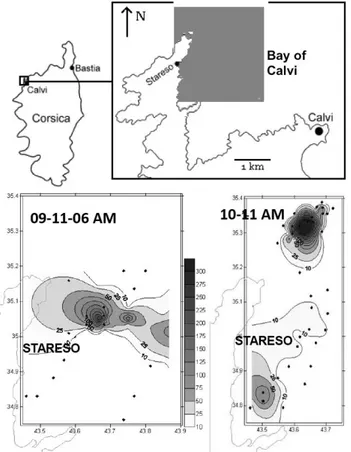PROBLEMATIC OF THE PELAGIA NOCTILUCA OUTBREAKS IN THE BAY OF CALVI (CORSICA)
J. Hecq *, A. Goffart , A. Collignon , M. Garrido , P. Lejeune and V. Pasqualini
Université de Liège- Océanologie, Centre MARE - jh.hecq@ulg.ac.be
University of Corsica Pasquale Paoli, Corte (Corsica), France
STARESO SA, Calvi (Corsica), France
Abstract
The interannual variations of the Schyphozoan jellyfish Pelagia noctiluca is estimated by weekly measurements in the Bay of Calvi
(Corsica) from 2003. The mean annual abundance reaches a dramatic maximum in 2006. The medusae appear by migration of active
swarms on the shelf and at the external limit of the Bay. Degraded individuals drift as passive swarms, throughout inner side of the
Bay and embayments.
Keywords: Ligurian Sea, Zooplankton , Medusae, Coastal Systems, Time Series
1 1 1 2 3 2
1 2
3
The cyclic outbreaks of the holoplanktonic jellyfish Pelagia noctiluca have been extensively described in the Western Mediterranean, where the seasonal progression of the P. noctiluca blooms commences in late autumn- winter. High densities are maintained throughout the winter and the blooms end in the summer after a maximum of reproduction [1]. In the Ligurian Sea, P. noctiluca characterizes generally the offshore waters and develops actively at the level of the Liguro-Provençal Front [2].P. noctiluca develops in swarms, mostly observed at the level of the pycnocline and which can migrate to the surface [3]. The swarms occasionally drift to the shelf and seem to be regulated by macroscale hydrography and the hydroclimatic environment [4], local upwelling [5] or oscillations of Liguro-Provençal [6].
Actually, many processes related to the causality and dynamics of outbreaks remain unknown, especially those concerning swarm formation, migration and drift, at the scale of coastal embayment. In order to enhance our understanding of the factors controlling the dynamics of P. noctiluca, its abundance has been estimated weekly during 7 years (2003 - 2008) in the Bay of Calvi (Corsica) by visual observations, scuba diving and WP2 zooplankton sampling.
Fig. 1. Variation of a jellyfish Pelagia noctiluca swarm in the Bay of Calvi from 8 till 10 November 2006. Points represent the positions of counting by an onsurface diver. The concentrations express themselves in number of individuals counted on a radius of 10 m. Scale varies from 0 to 300 ind
The mean annual P. noctiluca abundance shows a progressive increase from 2004 to 2005 and reaches a dramatic maximum in 2006, followed by a progressive decrease during the summers 2007 and 2008. The P. noctiluca outbreaks start generally in late autumn-winter, maintain throughout the winter and disappear in spring. However, some years (e.g. 2005 to 2007), the seasonal progression continues during the late spring and large populations maintain during the summer. The outbreaks of P.noctiluca in 2006 could be correlated to the very intense mesozooplankton bloom in 2005
The distribution of swarms in the Bay of Calvi has been studied by scuba visual observations. Active swarms of 200 m of length and 50 m of wide appear on the shelf and at the external limit of the Bay by vertical migration, following some days of North-East (Fig.1). The swarms maintain in the same area for a few days. In these active swarms, 5 to 10 P. noctiluca per m³ were observed between 10 to 60 meters depth. The individuals were equidistant, swimming actively with the extended tentacles and capturing the food. In certain cases, individuals partially destroyed, dying or at the end of their biological cycle, escape from active swarms and derive passively in the first meters of the water column towards the coastal zones and embayments under the effect of the wind and the movements of the water. The degraded individuals which have lost tentacles or manubrium, move slowly and accumulate in large number (sometimes more than 200 m ), edge to edge, in passive patches limited to the first three meters of water column. These swarms undergo an active predation by numerous sparid fishes. They disappear in a few hours, reduced by this predation or by massive sedimentation of the dead animals.
Acknowledgments: The study was done in the programme MEDUSE granted by the Agence Française de l’Eau (Rhone- M éditerranée- Corse). We thank Sylvain Plazza and the STARESO staff for sampling operations. JH Hecq is Senior research associate to the FRS-FNRS (Belgium).
References
1 - Licandro P., Daly Yahia M.N., Fernandez de Puelles M.L., Gasparini S., Hecq J.-H., Tranter P. and Kirby R.R. Spatial and temporal extent of a blooming jellyfish in the Northeast Atlantic and Mediterranean Sea. Submitted to Biological Letters.
2 - Morand P., Goy J. et Dallot S., 1992. Recrutement et fluctuations à long-terme de Pelagia noctiluca (cnidaria, scyphozoa), Annales de l’Institut Océanographique, 68(1-2):151-158.
3 - Malej A., 1989. Behaviour and trophic ecology of the jellyfish Pelagia noctiluca (Forsskil, 1775). J. exp. mar. Biol. Ecol., 126: 259-270.
4 - Zavodnik D.,1987. Spatial aggregations of the swarming jellyfish Pelagia noctiluca (Scyphozoa). Mar. Biol. 94(2):265-269.
5 - Skliris N., Goffart A., Hecq J.H. and Djenidi S, 2001. Shelf-slope exchanges associated with a steep submarine canyon off Calvi (Corsica, NW Mediterranean Sea): A modelling approach. Journal of Geophysical Research, 106 (C9) : 19883-19902.
6 - Goffart A., Hecq J.H. et Prieur L.,1995. Contrôle de la distribution du plancton par le front Liguro-provençal (secteur corse): Evolution saisonière et variabilité interannuelle. Oceanologica Acta, 18(3): 329-342.
-2
542
